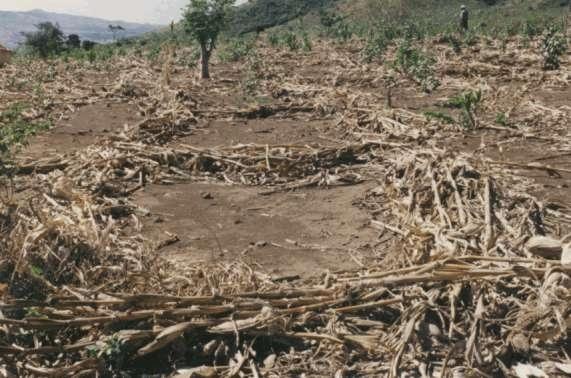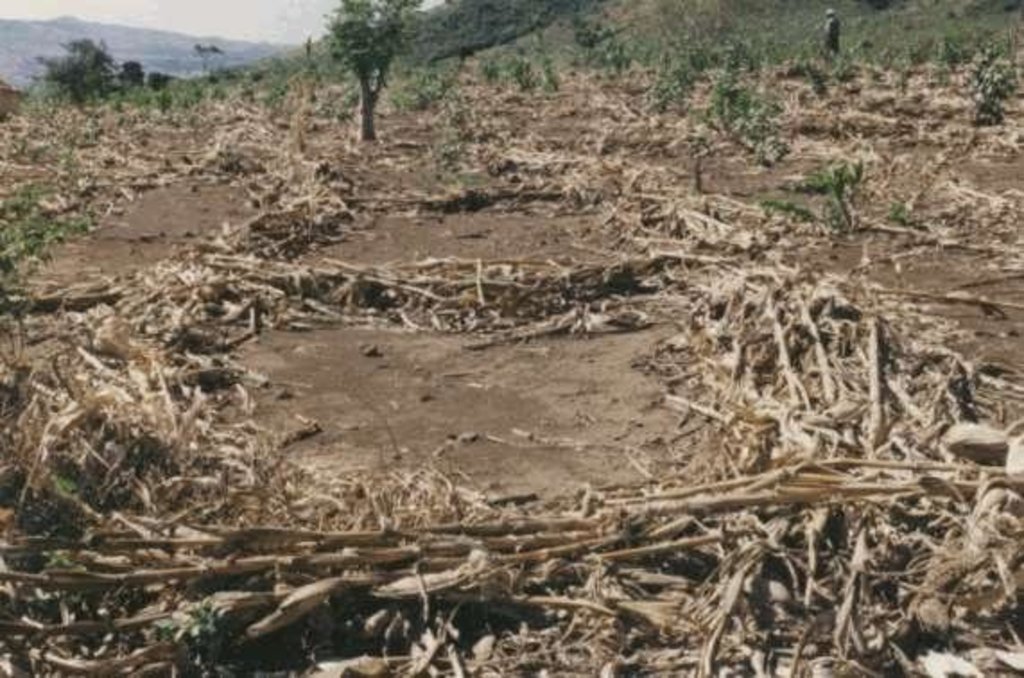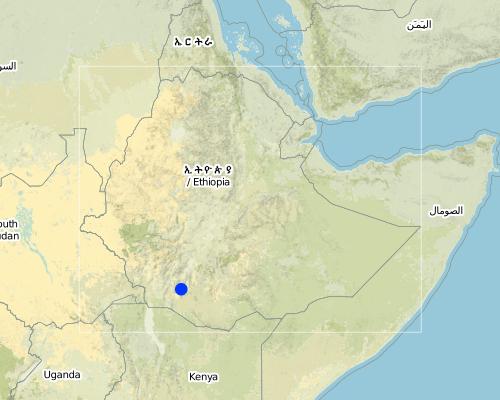Trashlines [埃塞俄比亚]
- 创建:
- 更新:
- 编制者: Unknown User
- 编辑者: –
- 审查者: Fabian Ottiger
Mona (Konso), Setera (Amharic)
technologies_1387 - 埃塞俄比亚
查看章节
全部展开 全部收起1. 一般信息
1.3 关于使用通过WOCAT记录的数据的条件
(现场)数据是什么时候汇编的?:
27/06/1995
编制者和关键资源人员接受有关使用通过WOCAT记录数据的条件。:
是
2. SLM技术的说明
2.1 技术简介
技术定义:
Agronomic/structural measure using straw of maize and/or sorghum.
2.2 技术的详细说明
说明:
Trashlines are constructed seasonaly by the family members using maize and/or sorghum straws. It has multi purposes like water harvesting, soil trapping, soil fertility improvement, etc. It is common in gentle to steep slopes in semi-arid areas.
2.3 技术照片
2.5 已应用该技术的、本评估所涵盖的国家/地区/地点
国家:
埃塞俄比亚
区域/州/省:
Southern region
Map
×2.6 实施日期
如果不知道确切的年份,请说明大概的日期:
- 50多年前(传统)
2.7 技术介绍
详细说明该技术是如何引入的:
- 作为传统系统的一部分(> 50 年)
注释(项目类型等):
According the farmers it is an indigenous technology past from generation to generation (ancestors).
3. SLM技术的分类
3.1 该技术的主要目的
- 减少、预防、恢复土地退化
3.2 应用该技术的当前土地利用类型

农田
- 一年一作
- 多年一作(非木材)
注释:
Major land use problems (compiler’s opinion): Rainfall shortage. Farm land shortage.
Major land use problems (land users’ perception): Rainfall shortage. Crop/livestock diseases. Farm land shortage.
3.3 有关土地利用的更多信息
该技术所应用土地的供水:
- 雨养
每年的生长季节数:
- 1
具体说明:
Longest growing period in days: 90 Longest growing period from month to month: Jul - Sep
3.4 该技术所属的SLM组
- 横坡措施
3.5 技术传播
具体说明该技术的分布:
- 均匀地分布在一个区域
如果该技术均匀地分布在一个区域上,请注明覆盖的大致区域。:
- 1,000-10,000 平方千米
注释:
Total area covered by the SLM Technology is 2000 m2.
3.6 包含该技术的可持续土地管理措施

农艺措施
- A1:植被和土壤覆盖层
注释:
Main measures: agronomic measures
3.7 该技术强调的主要土地退化类型

土壤水蚀
- Wt:表土流失/地表侵蚀

化学性土壤退化
- Cn:肥力下降和有机质含量下降(非侵蚀所致)

水质恶化
- Ha:干旱化
注释:
Main type of degradation addressed: Wt: loss of topsoil / surface erosion, Cn: fertility decline and reduced organic matter content, Ha: aridification
4. 技术规范、实施活动、投入和成本
4.2 技术规范/技术图纸说明
Technical knowledge required for field staff / advisors: low
Technical knowledge required for land users: low
Main technical functions: increase of infiltration, increase / maintain water stored in soil, water harvesting / increase water supply
Secondary technical functions: reduction of slope angle, reduction of slope length, improvement of ground cover, increase in organic matter, improvement of soil structure
Construction material (other): Maize and/or sorghum straws
For water harvesting: the ratio between the area where the harvested water is applied and the total area from which water is collected is: 1:3
Vegetation is used for stabilisation of structures.
4.3 有关投入和成本计算的一般信息
其它/国家货币(具体说明):
Birr
注明美元与当地货币的汇率(如相关):1美元=:
7.0
注明雇用劳工的每日平均工资成本:
1.00
4.4 技术建立活动
| 活动 | 措施类型 | 时间 | |
|---|---|---|---|
| 1. | 1. Harvesting grain/cop | 结构性的 | dry season |
| 2. | 2. Browsing leaves by livestock | 结构性的 | dry season |
| 3. | 4. Layout of straw | 结构性的 | dry season |
| 4. | 3. Cutting straw | 结构性的 | dry season |
4.6 维护/经常性活动
| 活动 | 措施类型 | 时间/频率 | |
|---|---|---|---|
| 1. | Harvesting grain/cop | 农业学的 | dry season / annual |
| 2. | Browsing leaves by livestock | 农业学的 | dry season / annual |
| 3. | Cutting straw | 农业学的 | dry season / annual |
| 4. | Layout of straw | 农业学的 | dry season / annual |
| 5. | Realignement of straw after storms | 结构性的 | dry season/as needed |
4.7 维护/经常性活动所需要的费用和投入(每年)
注释:
On gentle slope, spacing of 4 m between lines, average wealth of farmer.
4.8 影响成本的最重要因素
描述影响成本的最决定性因素:
Competition with fodder and fuel wood.
5. 自然和人文环境
5.1 气候
年降雨量
- < 250毫米
- 251-500毫米
- 501-750毫米
- 751-1,000毫米
- 1,001-1,500毫米
- 1,501-2,000毫米
- 2,001-3,000毫米
- 3,001-4,000毫米
- > 4,000毫米
农业气候带
- 半干旱
5.2 地形
平均坡度:
- 水平(0-2%)
- 缓降(3-5%)
- 平缓(6-10%)
- 滚坡(11-15%)
- 崎岖(16-30%)
- 陡峭(31-60%)
- 非常陡峭(>60%)
地形:
- 高原/平原
- 山脊
- 山坡
- 山地斜坡
- 麓坡
- 谷底
垂直分布带:
- 0-100 m a.s.l.
- 101-500 m a.s.l.
- 501-1,000 m a.s.l.
- 1,001-1,500 m a.s.l.
- 1,501-2,000 m a.s.l.
- 2,001-2,500 m a.s.l.
- 2,501-3,000 m a.s.l.
- 3,001-4,000 m a.s.l.
- > 4,000 m a.s.l.
5.3 土壤
平均土层深度:
- 非常浅(0-20厘米)
- 浅(21-50厘米)
- 中等深度(51-80厘米)
- 深(81-120厘米)
- 非常深(> 120厘米)
土壤质地(表土):
- 中粒(壤土、粉土)
表土有机质:
- 中(1-3%)
- 低(<1%)
如有可能,附上完整的土壤描述或具体说明可用的信息,例如土壤类型、土壤酸碱度、阳离子交换能力、氮、盐度等。:
Soil fertility is medium
Soil drainage/infiltration is good
Soil water storage capacity is high-medium
5.6 应用该技术的土地使用者的特征
非农收入:
- 低于全部收入的10%
相对财富水平:
- 平均水平
- 丰富
机械化水平:
- 手工作业
说明土地使用者的其他有关特征:
Population density: 50-100 persons/km2
Annual population growth: 2% - 3%
10% of the land users are rich and own 20% of the land (have additional sources of fodder / fuel wood).
30% of the land users are average wealthy and own 40% of the land.
60% of the land users are poor and own 40% of the land.
Off-farm income specification: Crafts, daily labourer
Level of mechanization is manual work (Hoe, sometimes oxen)
5.8 土地所有权、土地使用权和水使用权
土地所有权:
- 州
土地使用权:
- 个人
6. 影响和结论性说明
6.1 该技术的现场影响
生态影响
水循环/径流
地表径流
SLM之前的数量:
70
SLM之后的数量:
25
土壤
土壤流失
SLM之前的数量:
100
SLM之后的数量:
10
6.4 成本效益分析
技术收益与技术建立成本相比如何(从土地使用者的角度看)?
短期回报:
非常积极
长期回报:
非常积极
技术收益与技术维护成本/经常性成本相比如何(从土地使用者的角度看)?
短期回报:
非常积极
长期回报:
非常积极
6.5 技术采用
在所有采用这项技术的人当中,有多少人是自发地采用该技术,即未获得任何物质奖励/付款?:
- 90-100%
注释:
25000 land user families have adopted the Technology without any external material support
Comments on spontaneous adoption: estimates
There is no trend towards spontaneous adoption of the Technology
Comments on adoption trend: Confined in the area due to other cultures (oxen plough) outside the area.
7. 参考和链接
7.2 参考可用出版物
标题、作者、年份、ISBN:
Inventory of indigenous SWC measures on selected sites in the Ethiopian Highlands. SCRP Research Report 34. 1997.
可以从哪里获得?成本如何?
CDE
链接和模块
全部展开 全部收起链接
无链接
模块
无模块




